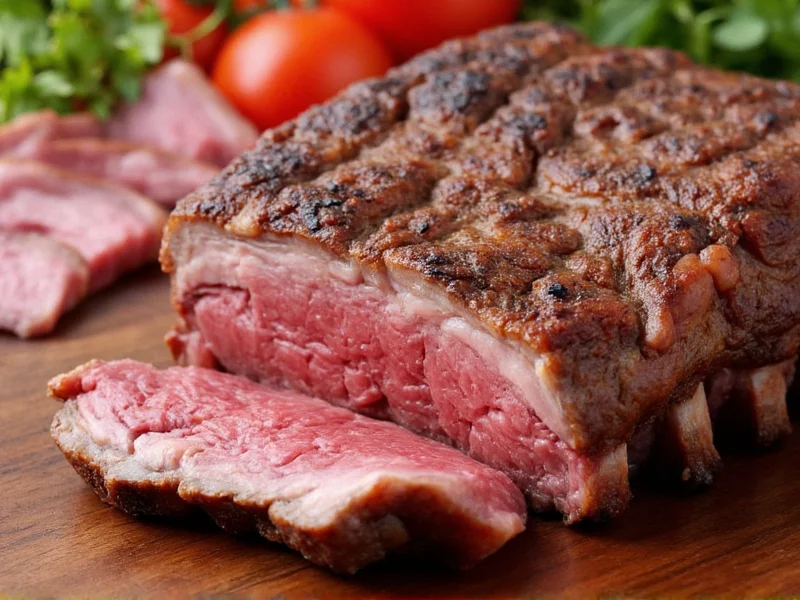Understanding the differences between short ribs and back ribs is essential for selecting the right cut for your culinary needs. These two popular beef cuts often cause confusion at the butcher counter, but their distinct characteristics significantly impact cooking outcomes.
Anatomical Origins and Butcher Terminology
Short ribs and back ribs come from completely different sections of the animal. Short ribs are harvested from the plate section (lower front chest area), specifically ribs six through ten. Butchers sometimes call these plate ribs or flanken when cut across the bone. Back ribs, technically known as loin ribs, come from the area behind the shoulder blades along the spine, typically ribs ten through twelve.
Physical Characteristics Compared
The most noticeable difference lies in their physical composition. Short ribs contain substantial meat both between and atop the bones, with significant marbling and connective tissue. Back ribs feature less meat relative to bone structure, with thinner layers of meat running between the bones.
| Characteristic | Short Ribs | Back Ribs |
|---|---|---|
| Source Location | Plate section (lower chest) | Loin area (near spine) |
| Meat-to-Bone Ratio | Higher meat content | More bone, less meat |
| Fat Content | Abundant marbling | Leaner profile |
| Connective Tissue | Substantial collagen | Less connective tissue |
| Typical Presentation | 3-bone sections, 3-4" thick | Full racks, 6-8" long |
Flavor and Texture Profiles
When comparing short rib vs back rib flavor characteristics, short ribs deliver a more intense beef flavor due to their higher fat content and marbling. The substantial collagen transforms into gelatin during slow cooking, creating that signature unctuous texture. Back ribs offer a milder beef flavor with more delicate texture when properly prepared. Their leaner composition means they can become dry if overcooked, while short ribs become more succulent with extended cooking.
Optimal Cooking Methods for Each Cut
Understanding proper cooking techniques represents the most crucial aspect of the short rib vs back rib decision. Short ribs require slow, moist-heat methods like braising, stewing, or smoking at low temperatures (225-275°F) for 3-6 hours. The extended cooking time breaks down tough connective tissues, yielding fork-tender results. Popular preparations include Korean galbi (when cut flanken-style), beef bourguignon, and classic braised short ribs.
Back ribs respond well to both dry and moist cooking methods but generally need less time. They excel with indirect grilling, smoking at moderate temperatures (250-275°F) for 3-4 hours, or oven roasting. Many cooks employ the 3-2-1 method (3 hours smoke, 2 hours wrapped, 1 hour glaze) for competition-style back ribs. Their leaner composition makes them less suitable for extended braising compared to short ribs.
Pricing and Availability Considerations
When evaluating short rib vs back rib cost factors, short ribs typically command a higher price per pound due to their superior meat content and flavor profile. Expect to pay 20-30% more for quality short ribs compared to back ribs. Availability varies by region—short ribs appear more consistently at specialty butcher shops, while back ribs remain widely available at most supermarkets. During holiday seasons, back ribs often see increased demand for barbecue preparations.
Selecting Quality Cuts: A Practical Guide
When choosing between beef short ribs vs pork back ribs (note: back ribs typically refer to pork, while short ribs are beef), examine these quality indicators. For short ribs, look for abundant marbling, deep red meat color, and bones with minimal exposed meat ends. The ideal short rib displays creamy white fat rather than yellowed fat. Back ribs should feature pinkish-red meat, minimal surface drying, and flexible bones that bend slightly without breaking.
Consider your cooking timeline when deciding between short ribs and back ribs. Short ribs require significant planning due to their lengthy cooking process, making them ideal for weekend cooking projects. Back ribs offer more flexibility for weeknight meals with their shorter preparation time. Both cuts benefit from dry brining (salting 12-24 hours before cooking) to enhance flavor and texture.
Storage and Preparation Best Practices
Proper handling affects the final outcome regardless of whether you've chosen short ribs or back ribs. Store both cuts in their original packaging if using within 2-3 days; otherwise, rewrap tightly in butcher paper. For optimal results, trim excess fat from short ribs before cooking, but retain enough to maintain moisture during the long cooking process. Back ribs benefit from membrane removal on the bone side to allow better flavor penetration and more even cooking.
When to Choose One Cut Over the Other
The decision between short ribs and back ribs ultimately depends on your culinary goals. Select short ribs when you want maximum beef flavor for dishes like red wine braises or Asian-inspired stews. They shine in recipes where rich, gelatinous texture enhances the dish. Choose back ribs when preparing barbecue-style dishes where tender meat with clean flavor profiles works best. Back ribs also suit recipes requiring shorter cooking times or when serving guests who prefer leaner meat options.











 浙公网安备
33010002000092号
浙公网安备
33010002000092号 浙B2-20120091-4
浙B2-20120091-4